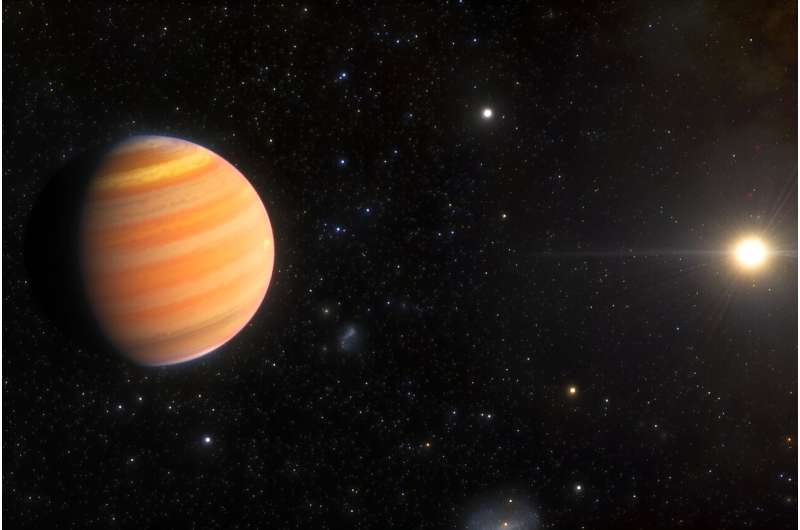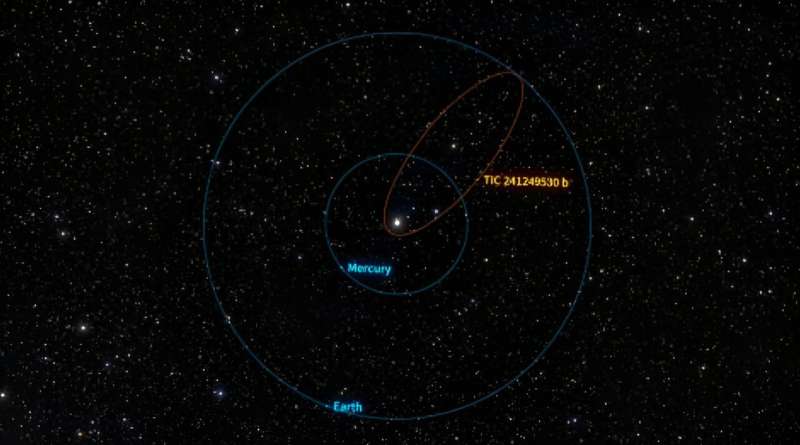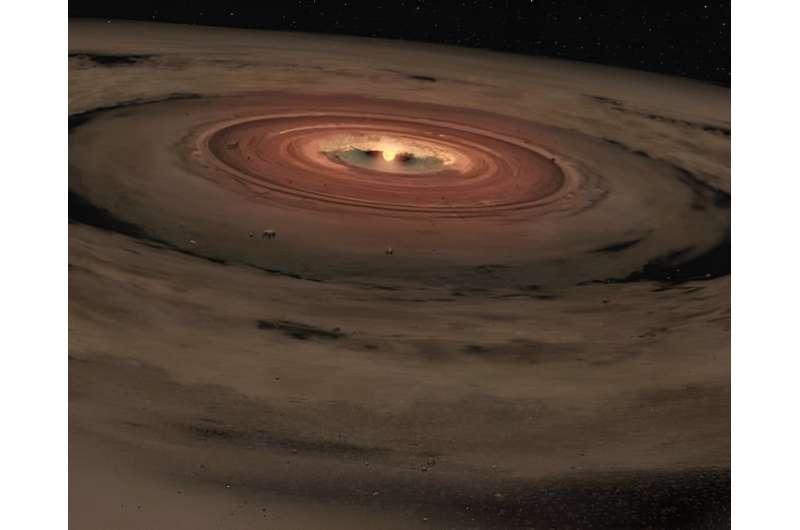This article has been reviewed according to Science X's editorial process and policies. Editors have highlighted the following attributes while ensuring the content's credibility:
fact-checked
peer-reviewed publication
trusted source
proofread
Is this how you get hot Jupiters?

When we think of Jupiter-type planets, we usually picture massive cloud-covered worlds orbiting far from their stars. That distance keeps their volatile gases from vaporizing from stellar heat, similar to what we're familiar with in our solar system. So, why are so many exoplanets known as "hot Jupiters" orbiting very close to their stars? That's the question astronomers ask as they study more of these extreme worlds.
It turns out that hot Jupiters don't actually start life snuggled up so close. Instead, they form much farther away from their stars in the protoplanetary nebula. That leads to the question: how did they migrate inward? The answer has been "we aren't sure" from the planetary science community.
However, astronomers at MIT, Penn State University, and a host of other institutions think they've got a handle on a better answer. They've found a hot Jupiter "progenitor." That's a juvenile version of a Jovian world slowly turning from cold to hot. The clues lie in its orbit and may give insight into how other planets evolve. The findings are published in the journal Nature.
Introducing a proto hot Jupiter
This new world is called TIC 241249530 b and it lies about 1,100 light-years away from us. Instead of circling its star in an almost circular elliptical orbit (our Jupiter does around the sun), this one is in a highly elliptical orbit. That squished "egg-shaped" path takes it very close to its star (like about 10 times closer than the orbit of Mercury. Then, it heads out to about the distance that Earth lies from the sun.
Not only is that a weird orbit, but it gets weirder. The path is "retrograde." That means its direction of travel is counter to the star's rotation. Think of it like this: The star rotates one way and the planet orbits the opposite way.
Both the highly elliptical orbit and the retrograde path tell planetary scientists that the formerly "cool" Jupiter-like world is evolving into one of those hot Jupiters. Now, if that isn't strange enough, the star the planet is orbiting is actually a binary star. That means it has a stellar companion.
Over time, successive interactions between the two orbits—of the planet and its star—force the planet to migrate ever closer to its star. That forces its elliptical orbit to change to a tighter, more circular one. That'll take about a billion years and that's when the planet will be fully evolved into a hot Jupiter.

How do hot Jupiters fit formation theory?
The standard theory about planetary formation usually requires that rocky worlds form closer to their stars than the gas and ice giants. That's because the heat of the newborn star vaporizes any "volatile" gases such as hydrogen away from newly forming planets. Worlds with a lot of those volatiles tend to form out where it's cooler and those gases don't get vaporized.
So, does this new world fit into that theory? According to MIT's Sarah Millholland, it does. "This new planet supports the theory that high eccentricity migration should account for some fraction of hot Jupiters," said Millholland.

"We think that when this planet formed, it would have been a frigid world. And because of the dramatic orbital dynamics, it will become a hot Jupiter in about a billion years, with temperatures of several thousand kelvin. So it's a huge shift from where it started."
So, this hot Jupiter (and many of the others seen in exoplanet surveys) started farther from its star. Then, through orbital interactions, it's been getting closer. That may well explain many of the hot Jupiters seen in exoplanet discoveries.
Simulations of orbital dances
"It is really hard to catch these hot Jupiter progenitors 'in the act' as they undergo their super eccentric episodes, so it is very exciting to find a system that undergoes this process," says Smadar Naoz, a professor of physics and astronomy at the University of California at Los Angeles, who was not involved with the study. "I believe that this discovery opens the door to a deeper understanding of the birth configuration of the exoplanetary system."
Of course, tracking the changes in exoplanet orbits can take a long time, so Millholland and her colleagues ran computer simulations. Those allowed them to model how this particular hot Jupiter could have evolved.
The team's observations, along with their simulations of the planet's evolution, support the theory that hot Jupiters can form through high eccentricity migration, a process by which a planet gradually moves into place via extreme changes to its orbit over time.
"It's clear not only from this, but other statistical studies too, that high eccentricity migration should account for some fraction of hot Jupiters," Millholland said. "This system highlights how incredibly diverse exoplanets can be. They are mysterious other worlds that can have wild orbits that tell a story of how they got that way and where they're going. For this planet, it's not quite finished its journey yet."
More information: Arvind F. Gupta et al, A hot-Jupiter progenitor on a super-eccentric retrograde orbit, Nature (2024). DOI: 10.1038/s41586-024-07688-3
Journal information: Nature
Provided by Universe Today





















